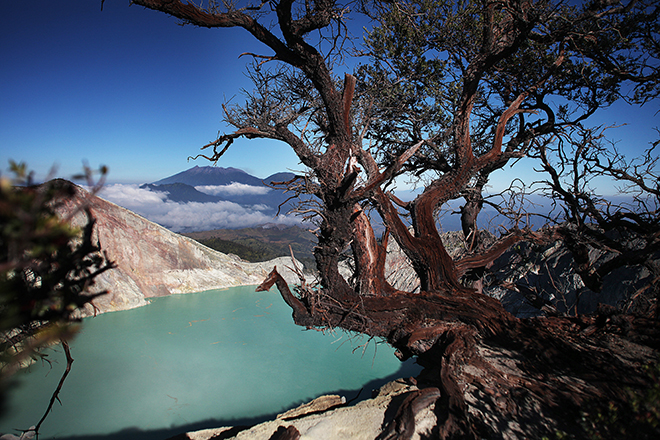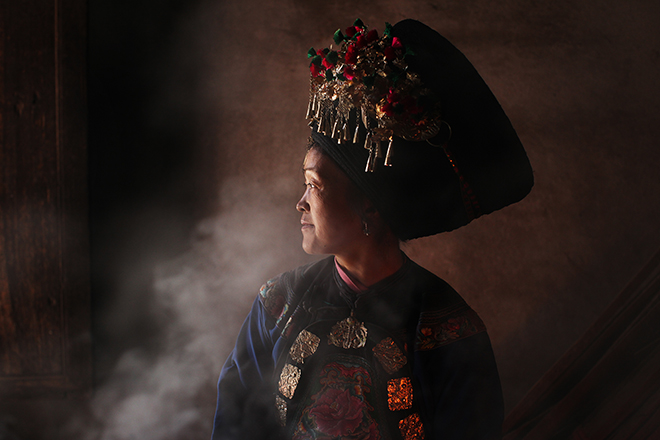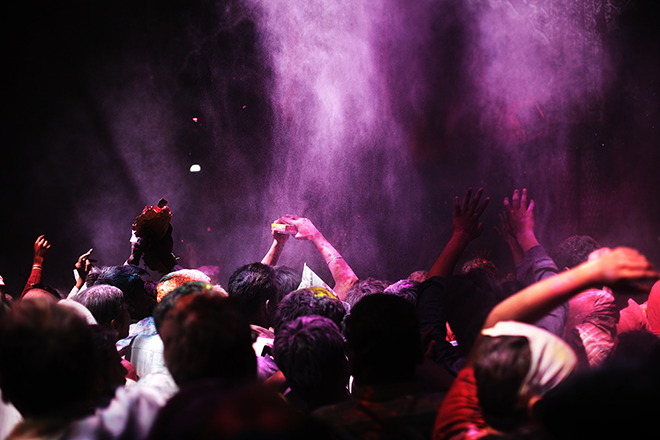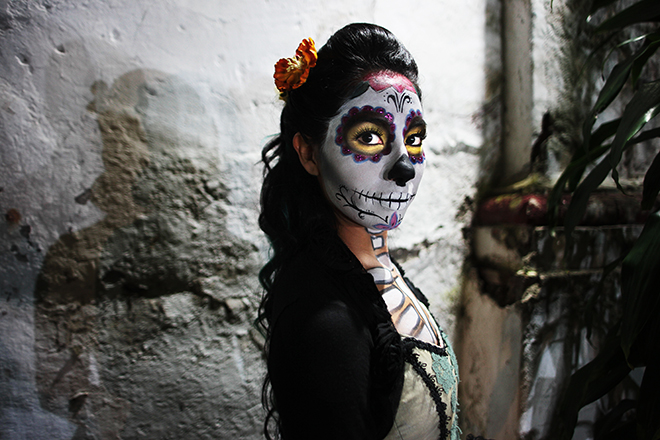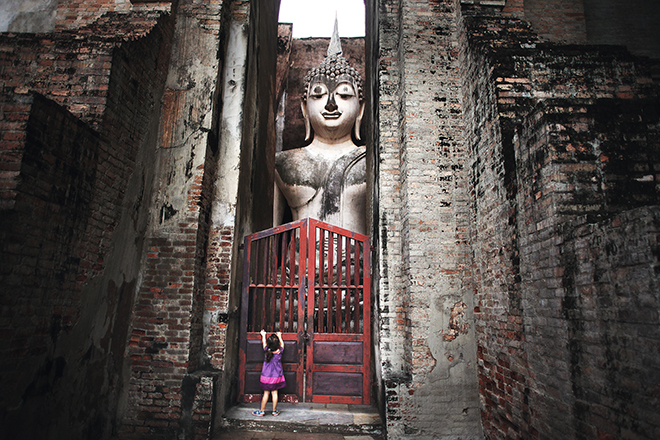Kawah ljen, the green crater of Java
Right from the start of a two-years voyage, I was thrust into the beating heart of Indonesia. The chaotic roads of Java led me towards the east, from one volcano to another, until I reached Kawah ljen, known as the "green crater". What sets this volcano apart is that within it nests a crater lake and a sulphur mine which underwent large-scale mining from the 60s onwards. After a steep climb to 2386 metres above sea level, setting off in the mist of dawn, I waited patiently for the first light of day to take the only photo that I would take from that viewpoint. The shadows gave way to sunlight that unveiled a breathtaking turquoise-hued lake. It's one of the most acidic lakes in the world, due to the sulphur that flows generously into it from one side of the crater, creating a sublime contrast between its bright yellow colour and the water’s green hues.
For this type of composition, try to give your shot volume by bringing an object into the foreground. This magnificent, twisted tree seemed like the perfect feature to include. Find one that captures your eye, even if it means walking a bit further… I like the way it hugs the lake, adding a touch of mystery and depth to the scene.
Woman from Miao tribe, China
With a population of over seven million people, the Miao are one of the largest ethnic minorities in South-Western China. Last year, I was lucky enough to spend a few days with a family in a remote village in the Hunan region. The Miao people live in very close-knit communities, but this does not make them wary of outsiders like me, quite the opposite.
The woman I photographed looked after me from morning to evening. I think she enjoyed being followed around everywhere, even into her kitchen, where I took her photo surrounded by fragrant aromas.
In a dark room, when you want to take somebody’s portrait, front light is to be avoided. An experienced photographer will choose light from just one side. You also have to guide the subject or have a good dose of patience so that he or she looks in the right direction without too much prompting. In this case, I composed the image using smoke which surrounded her face poetically.
Holi, a Hindu festival
Sometimes called the festival of colours, Holi is one of the biggest Hindu celebrations. In India, it marks the arrival of spring. Every photographer I know dreams of attending this vibrantly-coloured festival dedicated to the deity Krishna. I did everything I could to make sure I arrived at the right time to participate in these festivities. This ritual is an ode to colour with people gleefully coating one another with coloured powder.
Over the space of two days, I witness the fun-loving spirit of the Indian people in full swing in the streets. The holy temple of Banke Bihari in Vrindavan is the scene of intense excitement and frenzied activity. Everyone seems to rediscover their inner child, letting go of their inhibitions. Anyone who is not covered from head to toe quickly becomes the target of onlookers – both young and old.
Being a foreigner in this situation, you attract a lot of attention. One thing to be mindful of when there’s water, powder, and ashes floating around – protect your gear! That doesn’t mean you can’t take any photos, but you have to find a way to avoid ruining your camera because of a moment of carelessness. The solution I found was a clear plastic bag which allowed me to capture my subject but didn’t let anything else through. With a little bit of trial and error, and getting over my reservations, I managed to make my way through the festival-goers and take a few shots at shoulder-height. With arms stretching skywards, time seems to stand still under a rain of colour.
Día de los Muertos in Mexico
The Day of the Dead is a typical festival in Mexican culture. While visiting in November 2013, I took the opportunity to join the locals in Morelos, a small state 86 km south of the capital, Mexico City.
What surprised me the most about the experience is that Mexicans don’t seem fearful of death but rather they seem to taunt it and mock it. By day they all get together at the cemetery, but in the evening they go out and celebrate at huge dances organised for the occasion. Young people dress in beautiful clothing, their faces painted black and white to the point where they resemble ghoulish characters. Girls dress up as Catrinas, the skeletal character which epitomises this festival, and parade throughout the city squares.
Don’t be afraid to ask to take someone’s photo. It’s a souvenir photo you can’t go home without and these young people love nothing better than having their photo taken and being rewarded for their costume with a small note. Don’t think twice! It’s really great to capture their expressions through a viewfinder. The girl in this photo was particularly captivating, she had an air about her that was both dignified and mysterious. It only took one shot to get the look right, the next minute she had disappeared without a word… no doubt to add a touch of mystery to her character.
The little girl who wanted to see Buddha in Thailand
A few years ago in Thailand, I found myself face-to-face with thousands of Buddha statues. Some wooden, some made of stone, others yet gold-plated, carved or sculpted, each one appeared to be more beautiful than the next. But it was in Sukhothai that I truly fell in love with this age-old art form. The representation of Buddha in this country is at once fascinating and imposing.
The use of a wide-angle lens (24 mm) is almost essential considering the towering size of the statues. For a change, forget about long focal lengths, get up close and observe! They’re not going anywhere, so take your time to find the right light and the right frame. In this type of sanctuary, there’s always something afoot: an offering, a prayer… it’s up to you to seize the moment in an unobtrusive manner. Keep in mind that Thais are very religious and their places of worship should be treated with respect. Try to avoid appearing disrespectful by indiscriminately snapping away at every icon. Personally I prefer to wait until the end of the day, to capture the best light.
Giddy with admiration, I set off on the path back, leaving behind Wat Si Chum where I had spent a great deal of time before this monumental Buddha. Once the sanctuary doors closed behind me, a little girl sped past me, and grabbing desperately at the gate, struggled to catch a glimpse of something. Her mum, on holiday from Brazil, watched me take the photo and said to me: “She’s going to be sad, she loves Buddha.” As I moved closer to take a photo, the statue seemed to be watching her, ever so sorry about the situation…
Did you like it? Share it!
